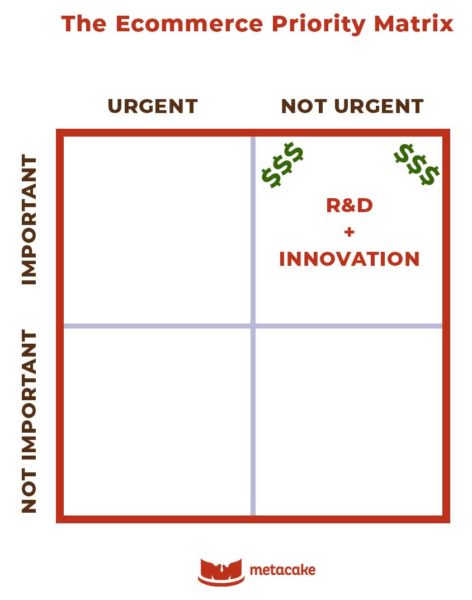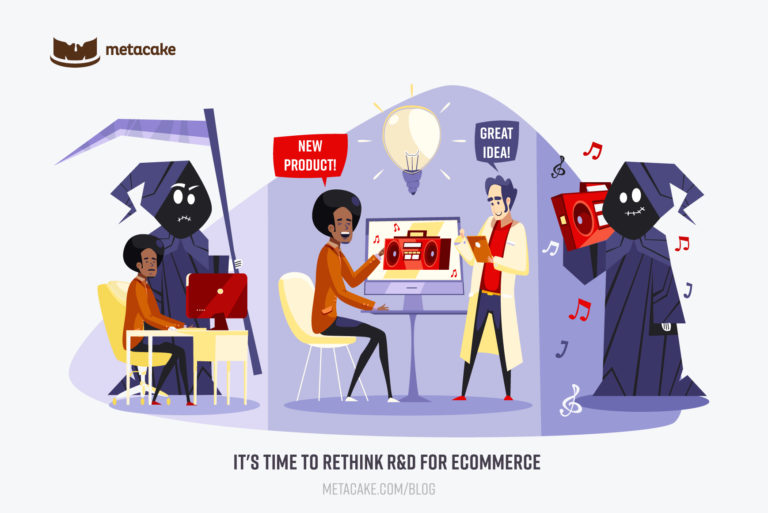“In this world, you’re either growing or you’re dying…”
― Lou Holtz
You’ve probably heard this said before and it is especially true for an ecommerce business.
For direct-to-consumer brands, innovation is essential. If your brand is not innovating, you can be sure that at least one of your competitors is and you’ll soon be out of the market.
That is why we are such big proponents of research and development (R&D). Continual product improvement is the only way to stay on top.
In this article: 1) we’re going to discuss the role of R&D as a growth driver not just a competitive edge. If you’ve read our article on scaling to the $50 million mark, you’ll know that R&D is the primary key to accessing that growth. 2) We will also give you a simple plan in order to start a healthy R&D program in your business.
R&D and Customer Lifetime Value
The key to a successful ecommerce business is developing fans of your brand that will purchase from you again and again (this is how you will achieve high customer lifetime value). That’s hard to do if you just have one stagnant product. You need to be increasing and improving your product line, and R&D is at the core of that effort.
There is no exception to this rule. Even if you’re product is consumable you need to be releasing new variations to maintain interest with your fans.
Whatever you sell, if you consistently bring better and better products to market, you’re on the path to increasing your bottom line.
Innovate or Die
Even if your goal is not to be at the top of your industry, R&D is important from a survival standpoint. All products have life cycles. Whether a product is a fad or an industry changes, understanding and anticipating those lifecycles is the way to future proof your business.
Kodak is a classic example of a company that failed to innovate. They went from the top of their game to the bottom in record time because they didn’t adapt appropriately. Don’t let it happen to you!
How to Grow Your Product Line?
The most crucial rule to follow when innovating and adding to your product line is this: make sure your all products are authentic to your brand. What we mean is this: you can’t simply tack on an arbitrary product to your product line to increase your AOV. Your new product needs to be better than your old product (shocking, I know) and it must be in line with your overall brand message.
This takes time. You cannot rush innovation. It is a process of research, feedback, trial and error. This is why you need to start innovating BEFORE you need it.
If you’re familiar with the Eisenhower Matrix, innovation would fall in the important, not urgent quadrant, or as we call it “The Money Box”. Almost all high-impact activities will fall into that box. In any business, especially ecommerce, it’s easy to be constantly in the urgent category and never access the real upside of working on things that will add massive return to your future.

Who is Involved in R&D?
The Soul of The Company
This could be the founder or entrepreneur, the head of the company, someone from marketing, or someone from the product team. This is the person that should lead R&D from an ideation standpoint. The person responsible for dreaming up the big ideas should be the most authentic person to the brand.
Lead Product Designer
This person is the hands and feet of R&D. Your lead product designer is another big-picture thinker with a lot of imagination. But unlike the soul of the company, the lead product designer has the skills to take these abstract ideas and turn them into reality. Look for someone talented, but scrappy, like a mad scientist. You need a jack-of-all-trades who can do a little of everything to bring a concept to life through a prototype so that its to pitch.
The Marketing Team
Your marketing team must be involved in R&D. They need to validate your new ideas to make sure they are viable. A product is no good, after all, if there is no market for it. Your new products must be in line with your brand and your customers’ needs.
Market Research
A market research team (or someone from your internal team) needs to be conducting market research prior to finalizing a new product. This can involve consumer studies and general market research. At the very least, run some focus groups so that you can get feedback from actual customers. Our favorite market research is done by polling your top customers.
Make sure to be adjusting and repeating the process of ideation, prototype design, validation from marketing, and market research to reach your final new product idea.
Advisors
Once you have your new product, present it to your advisors. This may be an actual board of directors or mentors and coaches. Get their buy-in that releasing this new product is a smart business decision for your company.
Sourcing Specialist
Once you have the green light, it’s time to get this product produced. Unless you’re manufacturing in house or have deep relationships with your factories, you need a good sourcing specialist. Sourcing is difficult, especially when you need to build new relationships to get your product manufactured. Find a sourcing specialist that already has these relationships in place.
Who Should Be in Charge of R&D?
As mentioned above, the soul of the company should be the person that owns R&D. It is their responsibility to invest in R&D and get feedback from all of the other stakeholders.
R&D is an investment that isn’t going to make money for 6-12 months or longer. For a fast-growing company, it is hard to spend time and money on R&D instead of other activities that produce revenue immediately.
In the important/urgency grid, money-box items are the important, but not urgent items. These are the items that will lead to the long term growth of your business, but often get ignored for urgent items.
That is why the soul of the company should be in charge of R&D. It takes foresight and vision to maintain this investment. And if you don’t invest in R&D now, when the time comes that you realize you need it, it will be too late.
This is a massive opportunity for your business. There are so many businesses that don’t invest in R&D. If you embrace R&D, you’ll find that you’re one of the few that do, and that will mean your brand can be the company that disrupts and leads innovation in your space.
What are some examples of good ecommerce R&D in action?
Here are a couple of examples of brands (who happen to be clients of ours) that are doing R&D really well.
Groove Life
Groove Life started out as a silicone ring brand. While their first products was an innovation on the silicone rings that were in the market at the time (making them breathable). How do you innovate from there? From a few original simple designs, Groove Life went on to innovate with new patterns and designs, and actually pioneered a new process for printing designs on silicone. From there they went on to expand their product line to include watch bands, and apparel and have since become one of the top active lifestyle brands in the market.
Old Spice
Old Spice is a retail giant. But as the landscape of retail is ever-changing, incredibly successful giants like Old Spice must work to innovate and move into the direct-to-consumer space. Old Spice is constantly testing and innovating. Just this year they launched an ecommerce site that allowed you to create your own custom body wash and deodorant from the scent to the packaging.
